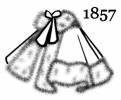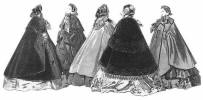 Full length cloaks or capes have been in fashion since time began. Undecorated it is one of the simplest garments to make. In examining the costume history of many countries a cloak may have another name such as burnous for what is essentially an enveloping blanket to either keep heat in or keep dust and sand out.
Full length cloaks or capes have been in fashion since time began. Undecorated it is one of the simplest garments to make. In examining the costume history of many countries a cloak may have another name such as burnous for what is essentially an enveloping blanket to either keep heat in or keep dust and sand out. The cloak or cape has doubled as a night blanket since early times. Not only the Romans and the Scots used a large piece of fabric in a damp cold Britain to protect themselves from the elements, but also the Arabs of the Middle East, who needed to brave the chill night desert.
Fashion history has many names for the same item and for centuries in Britain, mantle was another name for a hooded shapeless cloak with arm slits. Mantle from mentel originally meant men's cloak. It was a long surviving term for a loose garment with two decorative silk tassels and the name was used alongside cloak and cape. Like the cloak, the mantle was often worn flung on the shoulders in a casual way. The term mantle was used frequently throughout the 19th century and clothes manufacturers often called themselves MANTLE MAKERS or Makers of Mantles and Cloaks.
(Note BURNOUS derives from the Arabic word burnus and is usually a longwhite hooded cloak of coarse woollen cloth, worn throughout North Africa by the Arabs and Berbers.)
The Meaning of Cloak and or Cape
The word for cloak comes from the Latin cloca which means cape and of course there is a link with the Ancient French word cloke.
The correct term for the full garment is cloak. The correct costume history term for the attached collar or small extension that falls over the shoulders is called cape. However as the small cape developed into two and even three layers which often reached the waist, the word cape became used in an interchangeable way. Hooded cloaks were often referred to as capes and were sometimes known as Capucins.
I believe the term cape should not be applied to any cloak longer than hip length and that a cape is often of a more frivolous style than a cloak.
Early cloaks were very simple in cut. They could and still can be easily achieved by cutting a circle or near circle of fabric with a hole for the head - these were the sort that doubled as a blanket. The cloak used to prevent Queen Elizabeth 1st wetting her feet was more of a decorative flourishing fashion appendage.
Although cloaks continued to be used they developed into sophisticated lined, cut and even quilted semi shaped fashion garments, for indoor and outdoor wear.
Types of Coaks or Capes
The earliest cloaks were circular cloaks or wraps based on a circular shape. They can be anything from a half circle to a whole circle.
Fitted cloaks are more modern and involve some tailoring, because in some part they are shaped to fit the body, usually around the shoulders. They were first popular in the renaissance, but we mostly think of them as Victorian Opera Cloaks.
Finally there is the easy to make gathered cloak which began life in the middle ages. Either a rectangle or gores of joined fabric pieces are gathered onto a collar and the edges encased into the collar. Such spectacular cloaks are for those who like to make an entrance, Lord of the Rings fantasy players are good examples.
Long cloaks were popular with both sexes through the 16th and 17th centuries, although it is fair to say that women saw them as functional and respectable cover up garments, rather than fashionable. From about 1750 every British village woman owned a hooded cloak which was the usual outdoor wear. Riding dress used tailoring in coat making, but even by 1800 few women wore highly tailored outer coats then called the redingote. At the turn of the nineteenth century, tailoring with woollen cloth as we know it today was only in its infancy.
Between 1820 and 1840 cloaks were always more favoured by less fashion conscious older women as they were such a utilitarian item, but cloaks do appear regularly in documentation from 1740 to 1840. Some cloaks like these shown in illustrations above and below reached to the feet and others, like the Cardinal cloak similar to the C18th Cloak described below, rested about 6 or so inches from the ground.
Memorable cloaks in fashion history include the red cloak. In the 18th century a very popular cloak in Britain was the Cardinal, a three quarter cloak with a hood. This scarlet red woollen cloak remained very popular until 1800 and was similar in line the the 18th century cloak shown above. After about that date younger women began to favour mantles, shawls and the new pelisse style coat. Only older women continued to wear the scarlet cloak.
The use of scarlet cloth for hooded cloaks was so popular in 18th century Britain that it could be called a traditional British garment. In the book Fabric of Society written by the erudite costume authorities and authors Jane Tozer and Sarah Levitt a 'cardinal' cloak circa 1800 and originally from Mobberley in Cheshire, is described in the book as a hooded scarlet cloak.
Such cloaks were made of scarlet woollen cloth that had been double milled to increase the weather proof qualities. The cardinal cloak example the authors describe was a wedding cloak and was beautifully lined with a silk lining.
It had a silk lined hood under the lined, quilted collar, so that when the hood was in use the collar automatically got drawn up around the back neck and face making for a very warming experience. It was not full length for the woman of average height being about 6 inches or so from the ground. The length chosen was a workable one so that 45 inches or so was adequate for many women, lifting the cloak well off the ground, but giving good cover.
Although red was a commonly used colour for cloaks in Britain other colours were popular too and included grey, brown and blue. Welsh women like blue cloaks and the Irish wore black and grey versions, but they too were fond of blue and red cloaks when finance allowed the choice.
C18th cloaks were often made of broadcloth since because it was so tightly woven, it didn't unravel. Being made of pure wool it was also naturally hygroscopic having the facility to both reject water from the oily helical cuticle and hold moisture at the same time without feeling wet. The broadcloth selvedge was also sturdy and compact making it suitable to use as a firm simple edge, enabling easy construction at home. Such cloaks are very simple to make.
The scarlet cardinal cloak was symbolic in that it was associated with neat clean women who were respectably going about their business visiting their neighbours or attending worship on a Sunday.
The Victorians favoured a wide variety of styles of cloaks that include mantles and shorter capes as well as redingotes and pelisse coats, for both winter and summer. The loose fullness of a cloak was highly suitable for wearing over the wider romantic skirts and later the crinolines of the era. It was also a perfect loose covering to disguise pregnancy in the Victorian era always kept hidden from the public eye. As well as longer versions, shorter cloaks were very much in vogue from 1850 and hooded styles were often trimmed with tassels, fringe and braid.
| Caped Redingote | 1857 Short Cashmere Cape and Fur Trim |
 |  |
| Cloaks from a late 1850s copy of the Petit Courier des Dames. | |
 | |
The winter weather of 1861 was so severe in England that women wore the heaviest of fur or velvet cloaks.
In February 1861 the World of Fashion suggested 'The severity of the present season renders warm and comfortable cloaks and paletots indispensible(sic) for the promenade: velvet sealskin and veloutine or velvet pile are the materials considered the most stylish. Velvet manteaux are made long and and full with rich passementeries and black lace - or which is still more distingué, with fur; light sable being preferred.'
Likewise the Beeton publication 'The Englishwoman's Domestic Magazine' listed many mantles and cloaks with fancy names such as the Phoebus, the Shanghai, the Sultan, The Mexican the Diplomate and the Melazzo. Today they sound like the names of delicious fancy Belgian chocolates.
In 1863 the World of Fashion stated ' For paletots and sleeved cloaks, furs are considered the most stylish trimming: sable, marten and 'vison' are worn on black velvet; for violet, blue and claret velvets, ermine and chinchilla are more suited....'
In 1860 a sealfur pelisse would have been thought a luxury and may have cost about 20 guineas, a considerable sum at the time.
The short cloak construction was often merged with the hip length mantelet styles that became popular at the same time. Sometimes it is hard to tell where a cloak or cape ends and a mantelet begins. The mantelet and the dolman, along with the short cape were both useful styles that developed and changed as the crinoline gained back fullness and the bustle emerged. The bustle contour needed carefully contoured top clothing to preserve the hind leg like silhouette.
Until 1910 full length cloaks and capes were still worn, but often by more mature women. After that date they became rare by day, disappearing by 1915 mostly only to be seen then on Red Cross Nurses and service women.
Between 1900 an 1910 a huge variety of coat styles could be bought. The new oriental style cocoon coats also helped the demise of capes as the all enveloping nature of the cocoon coat fulfilled a similar, but more advanced cover of odd shapes function, that the cape or cloak had previously. The cocoon coat is shown on a later coat page.






.jpg)
No comments:
Post a Comment